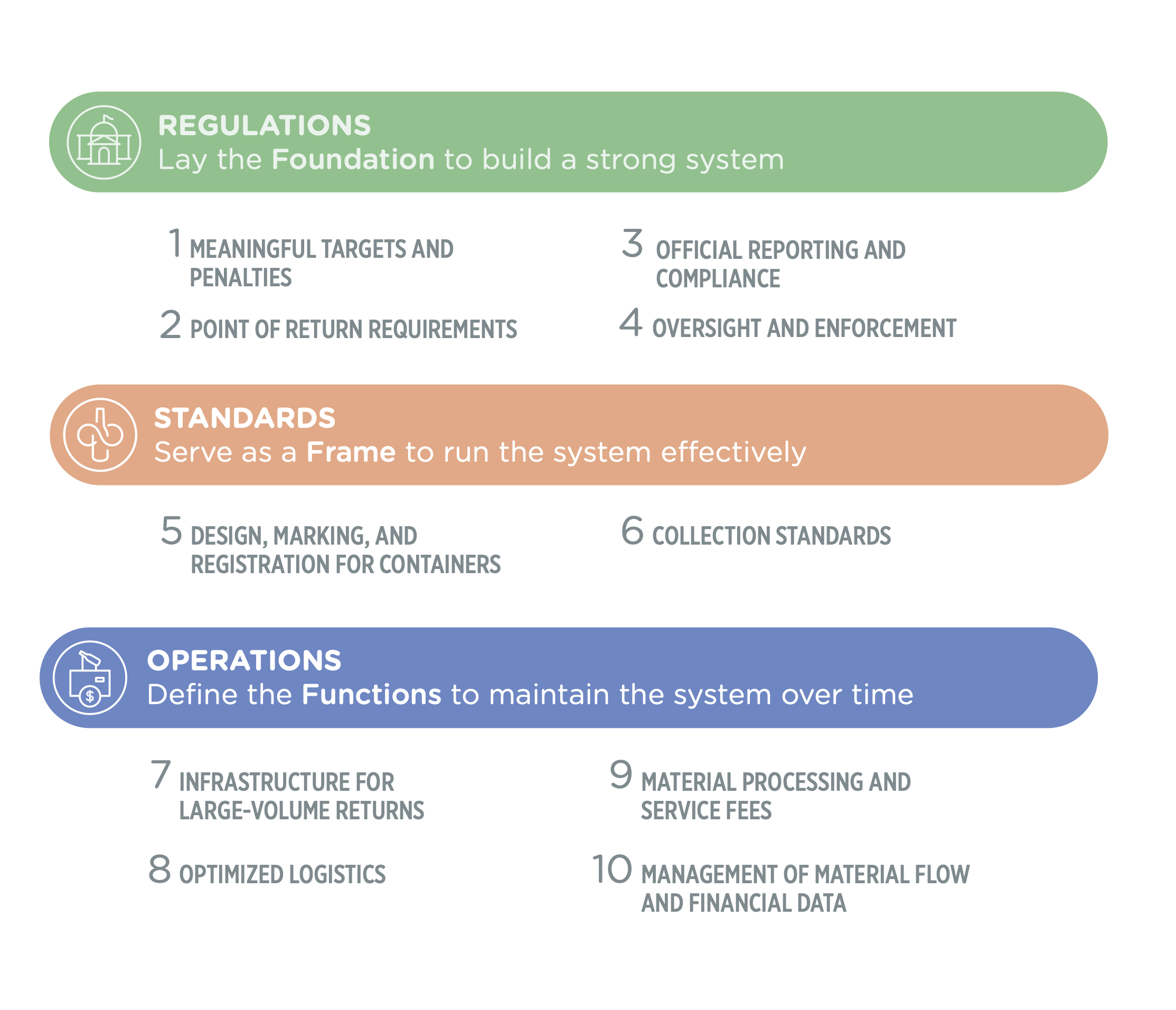Today, we shift from the “what” (the 10 Principles) to the “how” (the 10 Practices) of DRS!
Welcome to the 11th issue of Bottle Bill Common Ground — a limited-series newsletter from Reloop North America highlighting evidence-based guidance for legislators, policy makers, industry, and advocates working on bottle bills. (If you haven’t read our first 10 issues, you can do so here. And if you missed our last issue because of the July 4th holiday, you can read it here.)
This issue starts our shift from 10 high-performance principles that focus on what constitutes an effective deposit return system (DRS) to 10 essential practices — requirements on how to build, run, and maintain a modern DRS for beverage containers. Before diving into Practice 1, let’s look at how all 10 Practices come together to create a great DRS:

The first of these essential practices for bottle bill legislation is:

Setting clear targets for a DRS through legislation helps define common goals for producers, retailers, and regulators. Equally important is establishing adequate enforcement and meaningful penalties if targets are not met. Any system not backed by rigorous enforcement risks missing key targets and encouraging inappropriate behavior (wait for Practice 4: Oversight & Enforcement to learn more). The right mix incentivizes producers and system operators to maintain high performance in order to avoid penalties.
Meaningful targets provide performance benchmarks to help measure the public policy impact and assess the effectiveness or efficiency of the DRS at local and state-wide levels. Research consistently shows that a 90% collection target is attainable when bottle bill legislation and rules are the guide to build a properly designed system. High-performing DRSs in countries like Germany and Norway regularly achieve a 90% collection target, which inspires the system to maximize waste prevention and litter reduction, and facilitate high levels of closed-loop recycling.
In addition to a 90% collection rate, DRS legislation should require beverage producers and/or DRS operators to meet specific targets in the following areas:
- Recycling rate (material-specific and overall)
- Beverage packaging material
- Public awareness/satisfaction
- Minimum post-consumer recycled content
- Geographical coverage (i.e., minimum number of return points per person, maximum distance to return point)
Systems don’t improve overnight. DRS legislation needs to be rigorous but realistic, and allow performance expectations to gradually increase over time. The mandated collection target could, for example, increase by 5% annually until the maximum target of 90% is reached. When producers and DRS operators know targets will become progressively more ambitious, they can plan and make the necessary investments in infrastructure and innovation.
At a minimum, enforcement procedures and penalties need to be clearly stated in statute and regulations, along with the government agency responsible for enforcing them. Penalties are most effective when there is a clear connection between the expectations outlined in the targets and a direct line of responsibility back to a specific party. They must also be set high enough to ensure that the cost of compliance remains more economically attractive than the cost of non-compliance.
Case Study: Quebec
Quebec’s new DRS regulations will begin to be implemented in November 2023. They prescribe the following annual recovery rate targets for 2030:
- Single-use metal containers: 85%
- Single-use plastic containers: 80%
- Single-use containers made of glass: 80%
- Single-use fiber containers, including multi-layer containers: 70%
- Single-use biobased containers: 80%
- Reusable containers made of glass: 90%
- Reusable containers made of any material other than glass: 80
- All containers: 85%
To drive continuous improvement, the regulations also stipulate that:
- Starting in 2030, and every two years thereafter, recovery rates will be increased by 5% until they reach 90%
- A minimum of 50% of containers must be recycled in a closed-loop fashion
- By 2026, 80% of glass, aluminum and plastic must be recycled locally
- The same is required by 2028 for multi-layered and biobased containers
Quebec’s new regulations also prescribe clear monetary penalties to be imposed on various stakeholders who fail to meet legislated requirements:
- $2,000 to $10,000 for producers who fail to mark a barcode on redeemable containers
- $4,000 to $250,000 and $12,000 to $1,500,000 if retailers fail to comply with distance requirements that ensure access and equity for return sites
- $8,000 to $500,000 and $24,000 to $3,000,000 for producers or Producer Responsibility Organizations (PROs) who fail to meet requirements
- $10,000 to $1,000,000 and $30,000 to $6,000,000 for other infractions by producers or their PRO.
Thanks for reading! We encourage you to share this newsletter widely with those who want or need to know about these principles and practices. Working together from a common ground of knowledge, we can move good bottle bills forward. Sign up here to get these blog posts as emails.
